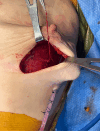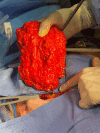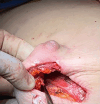Sensate immediate breast reconstruction
- PMID: 38720669
- PMCID: PMC11074667
- DOI: 10.21037/gs-23-416
Sensate immediate breast reconstruction
Abstract
As breast cancer therapies and associated oncologic outcomes continue to improve, greater attention has been placed on quality-of-life issues after breast cancer and breast cancer risk-reducing treatments. The loss of sensation that typically occurs after mastectomy can have significant negative psychological, sexual, and functional impact on patients after surgery. Further, injury of nerves not only leads to numbness, but can also cause chronic neuropathic pain, which can be very debilitating to affected patients. In order to minimize these impacts, there is expanding uptake of surgical approaches that preserve nerves at the time of mastectomy and reconstruct injured nerves either during mastectomy or during delayed reconstruction. These advances have been facilitated by anatomic studies investigating different variants of intercostal anatomy and better understanding the course of the nerves innervating the mastectomy skin and nipple-areolar complex (NAC). With improved knowledge of the intercostal nerve anatomy, surgeons are able to carefully preserve nerves at the time of mastectomy, thus improving sensory outcomes. Additionally, nerve reconstruction techniques have advanced, particularly with newer nerve allograft technologies, which allows for nerve reconstruction to be done both at the time of mastectomy, as well as in a delayed fashion. The focus of this article is to describe the current state of sensory preservation and immediate reinnervation at the time of mastectomy and the advances that have allowed for these new approaches.
Keywords: Mastectomy; breast reconstruction; breast sensation; sensory reinnervation.
2024 Gland Surgery. All rights reserved.
Conflict of interest statement
Conflicts of Interest: Both authors have completed the ICMJE uniform disclosure form (available at https://gs.amegroups.com/article/view/10.21037/gs-23-416/coif). The series “Hot Topics in Breast Reconstruction World Wide” was commissioned by the editorial office without any funding or sponsorship. A.W.P. is a consultant and speaker for Allergan (Abbvie), Sientra, and Axogen. Z.M.P. is a consultant and speaker for Axogen. The authors have no other conflicts of interest to declare.
Figures






Similar articles
-
Immediate targeted nipple-areolar complex re-innervation: Improving outcomes in immediate autologous breast reconstruction.J Plast Reconstr Aesthet Surg. 2021 Jul;74(7):1503-1507. doi: 10.1016/j.bjps.2020.11.021. Epub 2020 Dec 3. J Plast Reconstr Aesthet Surg. 2021. PMID: 33341386
-
Nerve Preservation and Allografting for Sensory Innervation Following Immediate Implant Breast Reconstruction.Plast Reconstr Surg Glob Open. 2019 Jul 24;7(7):e2332. doi: 10.1097/GOX.0000000000002332. eCollection 2019 Jul. Plast Reconstr Surg Glob Open. 2019. PMID: 31942359 Free PMC article.
-
Sensory Outcomes after Neurotization in Nipple-sparing Mastectomy and Implant-based Breast Reconstruction.Plast Reconstr Surg Glob Open. 2023 Dec 7;11(12):e5437. doi: 10.1097/GOX.0000000000005437. eCollection 2023 Dec. Plast Reconstr Surg Glob Open. 2023. PMID: 38074501 Free PMC article.
-
Sensory recovery and the role of innervated flaps in autologous breast reconstruction-a narrative review.Gland Surg. 2023 Aug 30;12(8):1094-1109. doi: 10.21037/gs-23-40. Epub 2023 Aug 11. Gland Surg. 2023. PMID: 37701293 Free PMC article. Review.
-
Collaboration between the breast and plastic surgeon in restoring sensation after mastectomy.Breast J. 2019 Nov;25(6):1187-1191. doi: 10.1111/tbj.13420. Epub 2019 Jul 1. Breast J. 2019. PMID: 31264296 Review.
Cited by
-
The Evolution of Implant-Based Breast Reconstruction: Innovations, Trends, and Future Directions.J Clin Med. 2024 Dec 5;13(23):7407. doi: 10.3390/jcm13237407. J Clin Med. 2024. PMID: 39685866 Free PMC article. Review.
-
Anatomical mapping of the 4th intercostal nerve's lateral cutaneous branch in both sexes: implications for advanced breast Reconstruction.Surg Radiol Anat. 2024 Dec;46(12):2019-2026. doi: 10.1007/s00276-024-03507-6. Epub 2024 Oct 14. Surg Radiol Anat. 2024. PMID: 39400569
-
Insights on preliminary outcomes of a prospective study examining innervation of deep inferior epigastric perforator flaps in autologous breast reconstruction.Gland Surg. 2025 Feb 28;14(2):242-245. doi: 10.21037/gs-24-475. Epub 2025 Feb 22. Gland Surg. 2025. PMID: 40115852 Free PMC article. No abstract available.
References
Publication types
LinkOut - more resources
Full Text Sources
Research Materials
